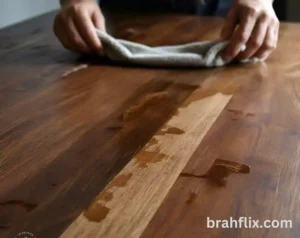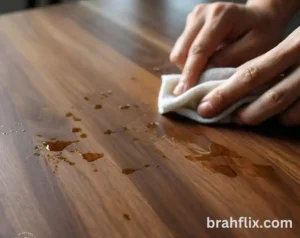Introduction
Water stains on wooden tables are a common nuisance that can mar the beauty of your furniture. Whether caused by spilled drinks, condensation from cups, or wet objects left on the surface, these stains can vary in severity from minor white rings to more persistent dark spots. Understanding how to remove water stains from wooden table is crucial for maintaining the table’s appearance and extending its lifespan. This comprehensive guide will walk you through various methods to tackle water stains effectively, using both household solutions and professional techniques.
Key Takeaways:
- Identify and differentiate between types of water stains and their causes.
- Employ various cleaning methods including natural remedies and specialized products.
- Follow preventive measures to avoid future water stains and maintain the table’s condition.
1. Understanding Water Stains on Wooden Tables
Water stains can appear in various forms on wooden surfaces, and their treatment depends on the type and severity of the stain.
Types of Water Stains:
- White Rings: Often caused by moisture from cups or glasses, these are typically surface-level stains.
- Dark Spots: Indicative of deeper moisture penetration, these stains are usually more challenging to remove and can be a sign of water damage.
- Blotchy or Cloudy Areas: These can result from prolonged exposure to water or steam, affecting the wood’s finish and causing discoloration.
Causes of Water Stains:
- Condensation: From cold drinks placed directly on the table.
- Spills: Accidental spills of beverages or water that are not cleaned promptly.
- Humidity: Excessive humidity can contribute to water damage and staining.
Tip:
Understanding the type and cause of the water stain helps in selecting the most effective cleaning method and preventing further damage.
2. Basic Cleaning Techniques for Minor Water Stains
For minor water stains, simple and effective cleaning techniques can often restore the wood’s appearance. Here’s a step-by-step guide:
Basic Cleaning Steps:
- Blot the Area: Use a clean, dry cloth to blot the area and remove any excess moisture. Avoid rubbing, as this can spread the stain.
- Apply Heat: Place a clean cloth over the stain and gently rub with a warm iron set to low heat. The heat helps lift the moisture from the wood. Be cautious not to overheat and damage the wood.
- Use a Wood Cleaner: If the stain persists, apply a wood cleaner designed for removing water stains. Follow the manufacturer’s instructions for application.
Recommendation:
For surface-level stains, these basic techniques are often sufficient. If the stain remains, further treatment may be necessary.
3. Natural Remedies for Removing Water Stains
Natural remedies can be effective for treating water stains on wooden tables. These solutions often use common household items and are gentle on the wood.
Popular Natural Remedies:
- Baking Soda and Water Paste: Mix equal parts of baking soda and water to form a paste. Apply the paste to the stain, let it sit for a few minutes, and then gently rub with a soft cloth.
- White Vinegar and Olive Oil: Combine equal parts white vinegar and olive oil. Apply the mixture to the stain using a soft cloth, and rub gently in a circular motion.
- Toothpaste: Non-gel toothpaste can be used to gently rub away surface-level water stains. Apply a small amount to the stain and rub with a soft cloth.
How to Use Natural Remedies:
- Apply the Remedy: Use a soft cloth or sponge to apply the chosen remedy to the stained area.
- Let It Sit: Allow the remedy to sit for a few minutes to break down the stain.
- Wipe and Polish: Wipe away the remedy with a clean, damp cloth, then dry the area thoroughly. Apply wood polish if necessary.
Tip:
Test any natural remedy on a small, inconspicuous area of the table before applying it to the stain to ensure it doesn’t cause damage.
4. Using Commercial Products for Water Stain Removal
For more stubborn water stains, commercial products designed specifically for wooden surfaces may be necessary. Here’s a guide to using these products:
Types of Commercial Products:
- Wood Stain Removers: These are formulated to break down and remove stains without damaging the wood.
- Furniture Polish with Stain-Removing Properties: Some furniture polishes include ingredients that help lift water stains while also conditioning the wood.
- Specialized Wood Cleaning Solutions: Designed for various types of stains, including water, grease, and ink.
Application Tips:
- Read the Instructions: Follow the manufacturer’s directions carefully to avoid damaging the wood.
- Apply Sparingly: Use a small amount of product on a clean cloth to apply it to the stain.
- Buff and Polish: After removing the stain, buff the area with a clean, dry cloth and apply a wood polish to restore shine.
Recommendation:
Choose products specifically designed for wood surfaces to ensure compatibility and effectiveness. Always test on a small area first.
5. Dealing with Dark or Persistent Water Stains
Dark or persistent water stains may require more intensive treatment. Here’s how to approach these tougher stains:
Steps for Removing Dark Water Stains:
- Sand the Area: For deep stains, lightly sand the affected area with fine-grit sandpaper to remove the stained layer. Be careful not to sand too aggressively, as this can damage the wood.
- Apply Wood Bleach: Use a wood bleach product to lighten the stain. Follow the manufacturer’s instructions and ensure proper ventilation.
- Refinish the Surface: After treating the stain, you may need to refinish the area by applying a wood stain or sealant to match the rest of the table.
Recommendation:
For severe cases, consider consulting a professional to avoid damaging the wood or affecting its appearance.
6. Preventive Measures to Avoid Future Water Stains
Preventing water stains from occurring in the first place can save you time and effort. Here are some preventive measures:
Preventive Tips:
- Use Coasters and Placemats: Protect the table surface from condensation and spills by using coasters for drinks and placemats for food.
- Apply a Protective Finish: Consider applying a protective finish or sealant to create a barrier against moisture.
- Regular Maintenance: Clean and condition the table regularly to maintain its finish and prevent damage.
Tip:
Encourage household members to use coasters and placemats consistently to reduce the risk of water stains and other damage.
7. Regular Maintenance and Care for Wooden Tables
Regular maintenance helps keep your wooden table in good condition and can prevent future stains. Here’s how to care for your table:
Maintenance Tips:
- Dust Regularly: Use a soft, dry cloth to dust the table and prevent grit from causing scratches.
- Clean Spills Promptly: Address spills and stains as soon as they occur to prevent them from setting.
- Condition the Wood: Apply a wood conditioner or polish periodically to nourish the wood and maintain its finish.
Recommendation:
Adopting a regular cleaning and maintenance routine can extend the life of your table and keep it looking its best.
8. Repairing and Restoring Wood After Stain Removal
After removing water stains, you may need to repair and restore the table’s finish to ensure a seamless appearance.
Repair and Restoration Steps:
- Fill in Any Scratches: Use a wood filler or crayon to address any scratches or blemishes caused by the stain removal process.
- Sand and Smooth: Lightly sand the area if needed to ensure a smooth surface.
- Reapply Finish: Apply a matching wood finish or polish to restore the table’s original appearance and protect the surface.
Tip:
For a professional-looking finish, consider consulting a furniture restoration expert if you’re unsure about the repair process.
9. Professional Cleaning and Restoration Services
For extensive damage or valuable tables, professional cleaning and restoration services may be the best option.
Benefits of Professional Services:
- Expert Techniques: Professionals use specialized tools and techniques to effectively remove stains and restore wood.
- Quality Results: Ensures a high-quality finish and preservation of valuable or antique furniture.
- Comprehensive Care: Provides thorough cleaning, repairing, and refinishing services.
Recommendation:
For valuable or antique wooden tables, investing in professional services can provide the best results and ensure long-term preservation.
Frequently Asked Questions (FAQs)
1. How can I remove stubborn water stains from my wooden table?
For stubborn stains, try using a mixture of baking soda and water or a wood stain remover. Lightly sand and refinish the area if needed.
2. Are there any natural methods for removing water stains from wooden furniture?
Yes, natural methods include using baking soda paste, white vinegar and olive oil mixture, or toothpaste. Test these methods on a small area first.
3. Can I use regular cleaning products on my wooden table to remove water stains?
Use wood-specific cleaners for best results. Avoid harsh chemicals or abrasive cleaners that could damage the finish.
4. How often should I apply a protective finish to my wooden table?
Apply a protective finish every 6-12 months or as needed, based on usage and wear, to maintain the table’s appearance and prevent stains.
5. When should I consider professional restoration services for my wooden table?
Consider professional services for severe stains, extensive damage, or valuable antique furniture that requires expert care.
Conclusion
Removing water stains from wooden tables requires a combination of understanding the stain type, using effective cleaning methods, and implementing preventive measures. By following the tips and techniques outlined in this guide, you can restore your table’s appearance and keep it in excellent condition.
Have you tried any of these methods to remove water stains from your wooden table? Share your experiences or ask questions in the comments below. For more tips on furniture care and maintenance, explore our other blogs and stay informed!